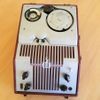1898: Poulsen records voice on magnetic wire
Valdemar Poulsen records Emperor Franz Josef of Austria at Paris exhibition





Familiar with Edison’s mechanical recording phonograph, American inventor Oberlin Smith (1840 - 1926) experimented in Bridgeton, N.J in 1878 with magnetic recording on steel wire and on cotton and silk threads impregnated with steel dust and fine wire clippings. Smith did not complete a working machine "on account of a press of other work." In 1888 he offered the idea to the public via an article in the British magazine Electrical World.
At the Copenhagen Telegraph Company, in 1898 Danish inventor Valdemar Poulsen (1869–1942) recorded his voice by feeding a telephone microphone signal to an electromagnet that he moved along a steel piano wire. In 1899 he filed a patent and founded a company to build the Telegraphone, a pioneering telephone answering machine. A simple version stored 2 minutes of audio on 130 mm (5 inch) diameter steel disks. A recording medium of steel wire wound around a cylinder held up to 30 minutes of audio. Poulsen’s associate Peder Oluf Pedersen (1874 - 1941) patented electroplating disks with different magnetizable materials. The Telegraphone received a Grand Prix at the 1900 Paris World Exhibition where it recorded Emperor Franz Josef of Austria.
In 1905, the American Telegraphone Company licensed Poulsen’s design for a dictating machine but wire recorders found limited acceptance until the development of vacuum tube amplifiers. Beginning in the 1920s, German, U.K. and U.S. companies built generations of machines for radio broadcasting and military applications. Steel tapes developed in Sweden in the 1930s significantly improved sound quality and remained in use by the BBC and other broadcasters into the 1950s but were eventually replaced by lower-cost tape media.
Contemporary Documents
- Smith, Oberlin. “Some Possible Forms of Phonograph” The Electrical World (September 8, 1888) p. 116
- Poulsen, Valdemar. “Method of recording and reproducing sounds or signals” U.S. Patent 661,619 (Filed: Jul 8, 1899 Issued: Nov 13, 1900)
- Pedersen, Peder O. “Magnetizable Body for the Magnetic Record of Speech” U.S. Patent 836,339 (Filed: June 21, 1901 Issued: Nov 20, 1906)
- Poulsen, Valdemar. “The Telegraphone: A Magnetic Speech Recorder” The Electrician (Vol. 46 1900) p. 208
More Information
- “Oberlin Smith and the Invention of Magnetic Recording” (Retrieved on 11.5.14 from: http://www.oberlinsmith.org/OberlinSmith/osmith.html)
- Engel, Friedrich Karl. “Oberlin Smith and the Invention of Magnetic Recording” (Retrieved on 11.14.14 from: www.richardhess.com/tape/history/Engel--Oberlin_Smith_2006.pdf)
- “Valdemar Poulsen Biography” (Retrieved 11.3.14 from: http://www.ieeeghn.org/wiki/index.php/Valdemar_Poulsen)
- “The Magnetic Tape of Valdemar Poulsen and Fritz Pfleumer” (Retrieved on 11.3.14 from: http://history-computer.com/ModernComputer/Basis/tape.html)
- Clark, Mark H. "The Magnetic recording of Sound" in Eric D Daniel, C. Denis Mee, Mark H. Clark eds. Magnetic Recording: The First 100 Years, IEEE Press (1999) pp. 6 - 46
- Clark, Mark H. & Henry Nielsen. “The Telegraphone” in Eric D Daniel, C. Denis Mee, Mark H. Clark eds. Magnetic Recording: The First 100 Years, IEEE Press (1999) pp. 15 – 29
Oral Histories
None identified
File name: 1898_Wire_v5
Rev: 8.24.17 [Webster image added]


